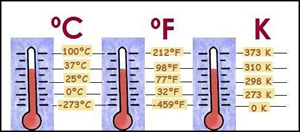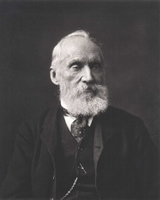Escalas de Temperatura - Temperature Scales
Na Grã-Bretanha utiliza-se oficialmente a escala Celsius ou Centigrade (ºC) para indicar temperatura. Nos EUA, essas escalas servem para propostas científicas. Exemplos:
a high of thirty-five degrees Celsius
The normal temperature of the human body is 37ºC.
A escala Fahrenheit (ºF) é utilizada em todos os demais contextos nos EUA e continua sendo comum na Grã-Bretanha. As palavras "degrees Fahrenheit / Centigrade / Celsius" são frequentemente omitidas:
Temperatures soared to over a hundred (100ºF).
She's ill in bed with a temperature of a hundred and two (102ºF).
The normal temperature of the human body is 98ºF.
Como a escala Fahrenheit apresenta números maiores do que aqueles com que estamos acostumados, cuidado para não se enganar. Se uma determinada temperatura ambiente for de 23ºF, por exemplo, prepara-se pois estará muito frio: cinco graus abaixo de zero!
Na tabela a seguir, você poderá conhecer as equivalências entre as três escalas de temperaturas mais comuns:

Water freezes at: (a água congela a)
nought degrees Celsius (0ºC)
thirty-two degrees Fahrenheit (32ºF)
two hundred and seventy-three Kelvin (273K) |
Water boils at: (a água ferve a)
one hundred degrees Celsius (100ºC)
two hundred and twelve degrees Fahrenheit (212ºF)
three hundred and seventy-three Kelvin (373K) |
[Reading texts produced by English native speakers]

Where did Kelvin Scale come from?
The Kelvin scale is named for British mathematician, physicist and engineer William Thompson, 1st Baron Kelvin (1824-1907), who contributed much to unify the discipline of physics in its modern form, writing about the need for an “absolute thermometric scale”.
Zero Kelvin is the lowest temperature that can be reached in the Universe. It is the temperature at which all motion stops at the atomic level. Zero Kelvin is also known as "absolute zero" - the absolute coldest possible temperature is 0 Kelvin, the theoretical absence of all thermal energy, which is equivalent to -273.15 degrees Celsius. |
Actually, in 2000, scientists from the Helsinki Universtity of technology claim to have achieved levels as low as 100 pico kelvin, or Ten thousand billionths of a degree (1×10−10K) and also, Zero Kelvin is not the lowest temperature that can be 'reached' simply because it is impossible to reach.
We measure how hot something is by how much the particles in it are vibrating. But what if we went to the point when the particles are not vibrating at all? That temperature is zero degrees Kelvin (absolute zero).
(Compiled From: Wikianswers and Wikipedia)
Saiba mais em Só Biologia - escalas de temperatura |
|


Como referenciar: "Escalas de Temperatura - Temperature Scales" em Só Língua Inglesa. Virtuous Tecnologia da Informação, 2008-2024. Consultado em 25/04/2024 às 17:22. Disponível na Internet em http://www.solinguainglesa.com.br/conteudo/numeros11.php































